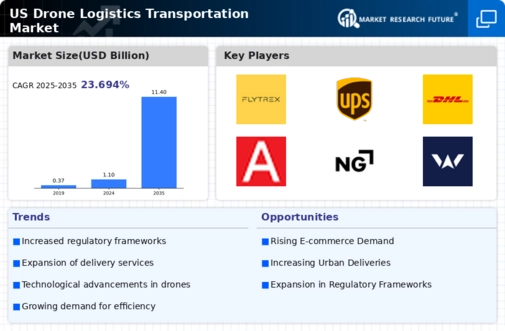The drone logistics-transportation market is currently characterized by a dynamic competitive landscape, driven by technological advancements and increasing demand for efficient delivery solutions. Major players such as Amazon (US), UPS (US), and Zipline (US) are at the forefront, each adopting distinct strategies to enhance their market positioning. Amazon (US) continues to innovate with its Prime Air service, focusing on rapid delivery capabilities, while UPS (US) emphasizes its extensive logistics network to integrate drone technology into its existing operations. Zipline (US), known for its medical supply deliveries, is expanding its service offerings to include commercial goods, thereby diversifying its operational focus and enhancing its competitive edge.
The market structure appears moderately fragmented, with a mix of established companies and emerging startups. Key players are increasingly localizing manufacturing and optimizing supply chains to improve efficiency and reduce costs. This collective influence of major companies shapes a competitive environment where innovation and operational excellence are paramount. The presence of diverse players fosters a competitive atmosphere that encourages continuous improvement and adaptation to market demands.
In October 2025, Amazon (US) announced the launch of its new drone delivery service in urban areas, aiming to reduce delivery times to under 30 minutes. This strategic move is significant as it positions Amazon (US) to capture a larger share of the last-mile delivery market, leveraging its existing infrastructure and technological capabilities. The emphasis on speed and efficiency aligns with consumer expectations for rapid service, potentially setting a new standard in the industry.
In September 2025, UPS (US) expanded its drone delivery pilot program to include rural areas, focusing on enhancing service accessibility. This initiative is crucial as it addresses the logistical challenges faced in less populated regions, thereby broadening UPS's market reach. By integrating drone technology into its operations, UPS (US) not only improves delivery efficiency but also reinforces its commitment to innovation in logistics.
In August 2025, Zipline (US) secured a partnership with a major retail chain to facilitate drone deliveries of consumer goods. This collaboration is indicative of Zipline's strategic shift towards commercial applications, which could significantly enhance its revenue streams. By diversifying its service offerings, Zipline (US) positions itself as a versatile player in the logistics sector, capable of meeting various market needs.
As of November 2025, current trends in the drone logistics-transportation market include a strong focus on digitalization, sustainability, and the integration of AI technologies. Strategic alliances among key players are shaping the competitive landscape, fostering innovation and collaboration. Looking ahead, it is likely that competitive differentiation will increasingly hinge on technological advancements and supply chain reliability, rather than solely on price. This shift underscores the importance of innovation and operational excellence in maintaining a competitive edge in the evolving market.




















Leave a Comment